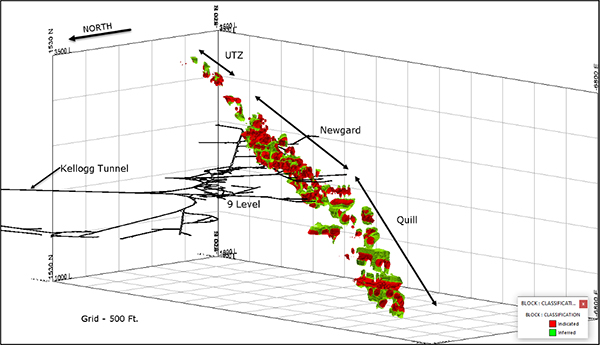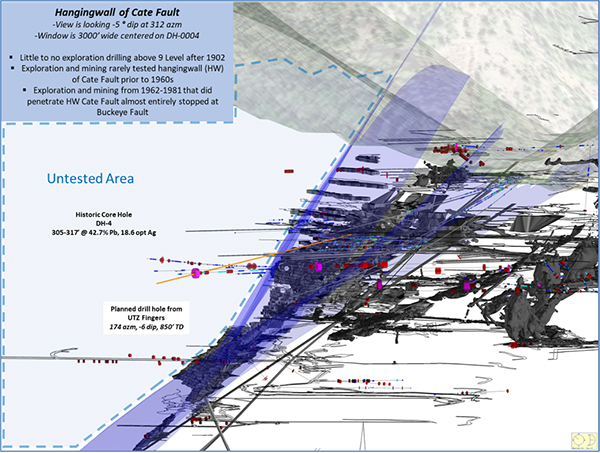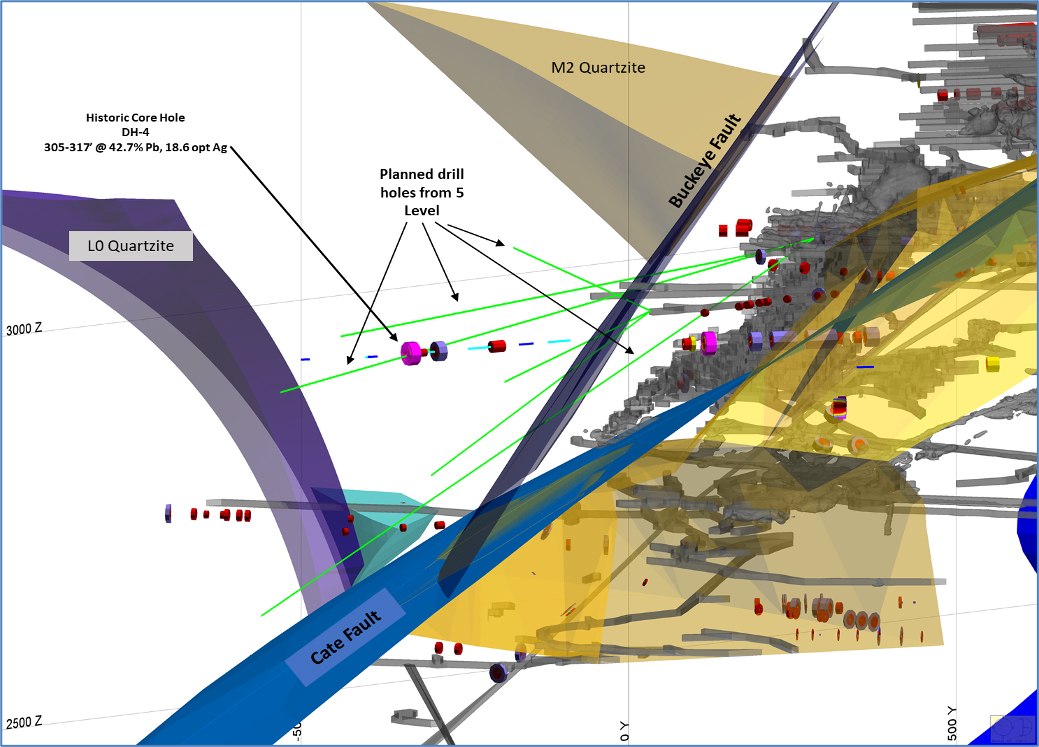News Releases
UPDATE -- Bunker Hill Announces Updated Mineral Resource and Identifies New Silver Exploration Targets
HIGHLIGHTS:
- Previous 8.8Mt Inferred resource significantly upgraded, supporting the rapid restart program:
- Indicated resource of 4.4Mt containing 3.03Moz of silver, 487M lb of zinc, and 176M lb of lead
- Inferred resource of 5.6Mt containing 8.3Moz of silver, 548M lb of zinc, and 312M lb of lead
- UTZ added new resource with successful silver exploration drilling
- The PEA remains on track for completion in early Q2-2021
- New, near surface silver exploration targets to be evaluated in current drilling campaign
TORONTO, March 22, 2021 (GLOBE NEWSWIRE) -- A release issued on March 19 included a formatting error that transposed the first and second paragraphs. This release has been updated to correct the formatting. The updated release follows.
Bunker Hill Mining Corporation (the “Company”) (CSE: BNKR) is pleased to report a significant resource increase at Bunker Hill Mine located in Idaho’s Silver Valley, USA. This underpins the Preliminary Economic Assessment (“PEA”), aimed the mine’s rapid restart potential, due to be published in early Q2-2021.
Sam Ash, CEO of Bunker Hill Mining, stated: “We are excited to see the results of our drilling campaign and continued digitization realized in this significant upgrade of the resource at Bunker Hill, building on the maiden resource we published less than a year ago. This demonstrates the mine’s outstanding mineral potential, which we expect to be reflected in the PEA assessing a rapid restart. This remains on track for delivery in early April. As part of the on-going campaign to add more silver to our resources, we have also identified some exciting new silver exploration targets in the upper levels of the mine which will be evaluated by drilling over the next few weeks”.
The on-going digital modernization program has yielded a three-dimensional model, defining nearly 100 years of mining voids and geology, which increases confidence in the estimation of mineralization. Additional drilling, modern data collection and assaying, quality assurance and quality control protocols, as well as the verification channel sampling program of 2020 has provided the necessary information to increase the confidence and classification of the Newgard, Quill and UTZ mineral resource estimates. The preponderance of data has converted approximately seventy-seven percent (77%) of the Bunker Hill Mineral Resource to the Indicated Mineral Resource category.
The Bunker Hill Mineral Resource, effective March 19, 2021, reported at a zinc cutoff grade of 3.3% is described below:
| Bunker Hill Resource Table |
||||
| Zinc Resources | K Tons | Pb% | Ag opt | Zn% |
| Indicated | 4,410 | 2.00 | 0.69 | 5.52 |
| Inferred | 4,569 | 1.67 | 0.83 | 5.66 |
| Lead-Silver Resources | K Tons | Pb% | Ag opt | Zn% |
| Indicated | - | - | - | - |
| Inferred | 1,050 | 7.56 | 4.28 | 1.50 |
| Total Resources | K Tons | Pb% | Ag opt | Zn% |
| Indicated | 4,410 | 2.00 | 0.69 | 5.52 |
| Inferred | 5,618 | 2.77 | 1.48 | 4.88 |
Mineral Resources are reported at a zinc cutoff grade of 3.3%. Mineral Resources are not Mineral Reserves and do not have demonstrated economic viability. Mineral Resources are reported in situ and undiluted. Mineral Resources meet the reasonable prospects of eventual economic extraction due to the fact that the entire vertical extents of the mineralization have been developed on mining levels every two-hundred feet. Newgard and Quill were being actively exploited and developed prior to the shutdown of mining operations in 1991. High grade capping was applied to the assays prior to grade estimation. Grades are estimated using Inverse Distance Cubed (ID3) interpolation techniques. Grades were estimated into a regularized 5 ft x 5 ft x 5 ft block model. A bull density of 11.3 cubic feet per ton was applied to the entire mineral resource based upon historic density values from production records at Bunker Hill. Two-hundred sixty-one (261) drillholes, totaling 29,380-feet, containing 5,720 Pb, Zn and Ag assays were used in the determination of mineralization. Assays were composited to 4,483 5-foot composites. Additionally, 4,545 historic production car samples and 394 channel sample verification samples were used for the resource estimate. Historic mining voids, stopes and development drifting have been accounted for in the resource estimate.
Figure 1: Oblique View of UTZ, Newgard and Quill Mineral Zones Showing Indicated and Inferred Mineralization
Significant New Silver Exploration Target Identified
New interpretation and analysis based on developments in the geologic model have identified an exciting new silver exploration opportunity in the hanging wall of the Cate Fault in the upper areas of the Bunker Hill Mine.
Silver production at Bunker Hill came largely from discrete Galena-Quartz Veins that formed ore shoots hosted in preferable quartzite beds of the Revett formation. The vein segments are bounded by large normal faults such as the Dull, Kruger and Sullivan Faults, which have down-dropped large blocks of the stratigraphy and veins down to the south, with >4000 ft of collective displacement. The more recent Cate Thrust Fault has then bisected this package of rocks, shifting rocks above the fault >500 ft up to the north.
The 3D modeling has allowed Bunker Hill geologists to project these vein segments back to their position at time of emplacement. The presence of high-grade silver veins such as the historically mined Sierra Nevada Vein in the hanging wall of the Cate Fault demonstrate that the width of the mineralizing system has not been discovered and the southern margin is unknown. The similar grades, thickness and mineralogy of the vein segments across the earlier normal faults shows that the vertical extent of the system was likely at least 4x the down-dip length of the individual veins. A similar set of normal faults, such as the Buckeye Fault, with significant down-to-the-south displacement also exists in the hanging wall of the Cate fault, with Ag-Pb-Zn mineralization indicated by historic and recent drilling in the hanging wall, or down-dropped portions of these faults.
Figure 2: Hanging Wall of Cate Fault
To summarize, none of the major faults that were historically thought as controlling ore emplacement actually bound the mineralizing system, and the entire Property is fully within the elevation and mineralogical zonation leading to silver, lead and zinc deposition.
The Cate Fault was the limit of most early mining in the upper parts of Bunker Hill, and it wasn’t until the 1960’s that it was recognized as having post-mineral offset. A few of the first core holes ever drilled in Bunker Hill in 1898 from the 5 Level were directed past the Cate and Buckeye Faults, with impressive results including 12’ @ 42.7% Pb and 18.6 opt Ag in DH-4, but mining largely shifted to below the 9 level after the Kellogg Tunnel was completed, and these holes were never followed up on. Bunker Hill is currently drilling to test these targets, and the holes are intersecting encouraging structures and lithologies similar to what has been modeled. Any mineralization encountered in these holes will be an entirely new vein system for Bunker Hill, not defined, named, mined or incorporated in any prior mine plans or resource estimates. Drill holes have been planned to systematically offset any successful intercepts in the first holes, and drill stations are being prepared to test these targets at appropriate angles and reduced distances. The locations of the targets are such that any mineralization defined with successful drilling could be rapidly incorporated in an update to mine plans or mineral resources.
Figure 3: Planned Drill Holes from 5 Level at Cate and Buckeye Faults
Note: The reader is cautioned that these are exploration-stage targets, which is speculative in nature, and there is no guarantee of positive drill results defining any economic mineralization.
A video summarizing the digitization process can be viewed at the following link https://youtu.be/8X3FrWfbGl4?t=229 . In addition, further information is available on our newly launched website.
Recent drill results are presented in the tables below.
ZINC INTERCEPTS
Hole 7046
| 7046 | From | To | M | ZnEq (%) | g/t Ag | %Pb | %Zn |
| 99.5 | 119.0 | 19.5 | 4.3 | 15.7 | 1.4 | 2.8 | |
| Including | 99.5 | 100.7 | 1.2 | 7.9 | 24 | 1.8 | 5.9 |
| 103.3 | 103.8 | 0.5 | 12.5 | 59 | 4.7 | 7.2 | |
| 105.8 | 107.3 | 1.5 | 7.0 | 21 | 1.9 | 5.0 | |
| 108.5 | 109.7 | 1.2 | 5.5 | 16 | 1.5 | 3.9 | |
| 113.8 | 115.2 | 1.4 | 10.2 | 41 | 4.3 | 5.7 |
Hole 7047
| 7047 | From | To | M | ZnEq (%) | g/t Ag | %Pb | %Zn |
| 92.2 | 93.1 | 0.9 | 9.7 | 9 | 0.4 | 9.1 | |
| 105.6 | 106.7 | 1.1 | 4.8 | 10 | 0.6 | 4.1 |
Hole 7052
| 7052 | From | To | M | ZnEq (%) | g/t Ag | %Pb | %Zn |
| 20.1 | 23.6 | 3.5 | 2.1 | 11.3 | 0.6 | 1.3 | |
| Including | 20.1 22.5 |
21 23.6 |
9 1.1 |
4.4 2.9 |
16 22 |
0.8 1.3 |
3.4 1.4 |
| 7052 | From | To | M | ZnEq (%) | g/t Ag | %Pb | %Zn |
| 37.2 | 44.5 | 7.3 | 2.4 | 7.8 | 0.5 | 1.8 | |
| Including | 37.2 | 38.1 | 0.9 | 2.8 | 18 | 1.5 | 1.1 |
| 39.5 | 39.8 | 0.3 | 9.2 | 26 | 2.0 | 6.9 | |
| 42.2 | 43.3 | 1.1 | 5.7 | 10 | 0.5 | 5.1 | |
| 43.3 | 44.5 | 1.2 | 4.0 | 12 | 0.7 | 3.2 |
Hole 7055A
| 7055A | From | To | M | ZnEq (%) | g/t Ag | %Pb | %Zn |
| 19.4 | 20.4 | 1.0 | 25.0 | 105 | 7.8 | 16.1 |
Hole 7061
| 7061 | From | To | M | ZnEq (%) | g/t Ag | %Pb | %Zn |
| 11.9 | 18.1 | 6.2 | 7.3 | 22.6 | 1.7 | 5.5 | |
| Including | 11.9 | 12.6 | 0.7 | 13.5 | 29 | 1.7 | 11.5 |
| 14.2 | 15.2 | 1 | 5.4 | 38 | 3.5 | 1.7 | |
| 15.2 | 16.5 | 1.3 | 6.6 | 17 | 1.3 | 5.2 | |
| 16.9 | 17.7 | 0.8 | 18.0 | 48 | 3.1 | 14.3 | |
| 17.7 | 18.1 | 0.4 | 13.4 | 20 | 1.4 | 11.7 |
SILVER INTERCEPTS
Hole 7046
| 7046 | From | To | M | AgEq g/t | g/t Ag | %Pb | %Zn |
| 134.1 | 159.4 | 25.3 | 92.3 | 12.8 | 1.0 | 1.2 | |
| Including | 138.1 | 139.5 | 1.4 | 255.4 | 38 | 2.5 | 3.4 |
| 142.6 | 143.7 | 1.1 | 180.5 | 26 | 2.6 | 1.8 | |
| 148.4 | 149.3 | 0.9 | 212.5 | 24 | 2.5 | 2.8 | |
| 158.9 | 159.4 | 0.5 | 332.4 | 65 | 3.4 | 4.0 |
Hole 7052
| 7052 | From | To | M | AgEq g/t | g/t Ag | %Pb | %Zn |
| 15.7 | 17.7 | 2 | 85.8 | 15.5 | 1.3 | 0.7 | |
| Including | 15.7 17.1 |
16.0 17.7 |
0.3 0.6 |
219.5 151.5 |
34 30 |
2.6 2.8 |
2.6 0.8 |
Hole 7052
| 7052 | From | To | M | AgEq g/t | g/t Ag | %Pb | %Zn |
| 32.9 | 33.5 | 0.6 | 348.3 | 43 | 3.98 | 4.2 |
Hole 7054
| 7054 | From | To | M | AgEq g/t | g/t Ag | %Pb | %Zn |
| 0.9 | 4.2 | 3.3 | 337.1 | 81.7 | 7.5 | 0.4 | |
| Including | 0.9 | 2.0 | 1.1 | 212 | 51 | 5 | 0.1 |
| 2.0 | 2.4 | 0.4 | 282.5 | 72 | 6.5 | 0.1 | |
| 2.4 | 3.6 | 1.1 | 610 | 149 | 13.7 | 0.7 |
Hole 7054
| 7054 | From | To | M | AgEq g/t | g/t Ag | %Pb | %Zn |
| 15.8 | 16.4 | 0.6 | 328.9 | 86 | 7.6 | 0.1 |
Hole 7055A
| 7055A | From | To | M | AgEq g/t | g/t Ag | %Pb | %Zn |
| 1.5 | 2.3 | 0.8 | 361.5 | 92 | 8.5 | 0.1 |
Hole 7064
| 7064 | From | To | M | AgEq g/t | g/t Ag | %Pb | %Zn |
| 131.7 | 132.4 | 0.7 | 357.2 | 138 | 7.0 | 0.01 |
*Due to poor recovery and for QA/QC purposes in portions of holes 7054, 7056 and 7063 and for QA/QC purposes, the company chose to report assay results based only on recovered footage. Drilled footage is NOT the reported width of the intercepts.
(Reported widths are intercepted ore lengths and not true widths, as relationships with intercepted structures and contacts vary. Prices used to calculate Ag and Zn Eq are as follows: Zn=$1.16/lb, Pb=$0.92/lb, Ag=$20/oz.)
Upcoming Events:
Alliance Global Partners (A.G.P) Mining Series Fireside Chat
March 23, 2021 @ 8:00am PT / 11:00am ET
Join Us: REGISTER NOW
Mining & Money Online Connect
March 24, 2021 @ 10:00am PT / 1:00pm ET
Join Us: REGISTER NOW
Technical Information
The diamond drilling program used HQ-size core. Bunker Hill followed standard QA/QC practices to ensure the integrity of the core and sample preparation through to delivery of the samples to the assay lab. The drill core was stored in a secure facility, photographed, logged and sampled based on lithologic and mineralogical interpretations. Standards of certified reference materials, field duplicates and blanks were inserted as samples shipped with the core samples to the lab.
ALS Global was used to provide analytical services and all results comply with both NI 43-101 and industry standards. ALS Global holds an industry standard ISO 17025 accreditation, specifying general requirements for laboratory performance.
The Company advises that it does not propose to base its production decision on a feasibility study of mineral reserves, demonstrating economic and technical viability, and, as a result, there may be an increased uncertainty of achieving any particular level of recovery of minerals or the cost of such recovery, including increased risks associated with developing a commercially mineable deposit. Historically, such projects have a higher risk of economic and technical failure. There is no guarantee that production will begin as anticipated or at all or that anticipated production costs will be achieved. The Company further cautions that a PEA is preliminary in nature. No mining study has been completed. Mineral resources are not mineral reserves and do not have demonstrated economic viability. There is no certainty that the PEA will be realized.
Qualified Person
Mr. Scott E. Wilson, CPG, President of Resource Development Associates Inc. and a consultant to the Company, is an Independent “Qualified Person” as defined by NI 43-101 and is acting at the Qualified Person for the Company. He has reviewed and approved the technical information summarized in this news release.
About Bunker Hill Mining Corp.
Under new Idaho-based leadership the Bunker Hill Mining Corp, intends to sustainably restart and develop the Bunker Hill Mine as the first step in consolidating a portfolio of North American precious-metal assets with a focus on silver. Information about the Company is available on its website, www.bunkerhillmining.com, or within the SEDAR and EDGAR databases.
For additional information contact:
Sam Ash, President and Chief Executive Officer
+1 208 786 6999
sa@bunkerhillmining.com
Cautionary Statements
Certain statements in this news release are forward-looking and involve a number of risks and uncertainties. Such forward-looking statements are within the meaning of that term in Section 27A of the Securities Act of 1933, as amended, and Section 21E of the Securities Exchange Act of 1934, as amended, as well as within the meaning of the phrase ‘forward-looking information’ in the Canadian Securities Administrators’ National Instrument 51-102 – Continuous Disclosure Obligations. Forward-looking statements are not comprised of historical facts. Forward-looking statements include estimates and statements that describe the Company’s future plans, objectives or goals, including words to the effect that the Company or management expects a stated condition or result to occur. Forward-looking statements may be identified by such terms as “believes”, “anticipates”, “expects”, “estimates”, “may”, “could”, “would”, “will”, or “plan”. Since forward-looking statements are based on assumptions and address future events and conditions, by their very nature they involve inherent risks and uncertainties. Although these statements are based on information currently available to the Company, the Company provides no assurance that actual results will meet management’s expectations. Risks, uncertainties and other factors involved with forward-looking information could cause actual events, results, performance, prospects and opportunities to differ materially from those expressed or implied by such forward-looking information. Forward looking information in this news release includes, but is not limited to, the Company’s intentions regarding its objectives, goals or future plans and statements. Factors that could cause actual results to differ materially from such forward-looking information include, but are not limited to: the ability to predict and counteract the effects of COVID-19 on the business of the Company, including but not limited to the effects of COVID-19 on the price of commodities, capital market conditions, restriction on labour and international travel and supply chains; failure to identify mineral resources; failure to convert estimated mineral resources to reserves; the inability to complete a feasibility study which recommends a production decision; the preliminary nature of metallurgical test results; delays in obtaining or failures to obtain required governmental, environmental or other project approvals; political risks; changes in equity markets; uncertainties relating to the availability and costs of financing needed in the future; the inability of the Company to budget and manage its liquidity in light of the failure to obtain additional financing, including the ability of the Company to complete the payments pursuant to the terms of the agreement to acquire the Bunker Hill Mine Complex; inflation; changes in exchange rates; fluctuations in commodity prices; delays in the development of projects; capital, operating and reclamation costs varying significantly from estimates and the other risks involved in the mineral exploration and development industry; and those risks set out in the Company’s public documents filed on SEDAR. Although the Company believes that the assumptions and factors used in preparing the forward-looking information in this news release are reasonable, undue reliance should not be placed on such information, which only applies as of the date of this news release, and no assurance can be given that such events will occur in the disclosed time frames or at all. The Company disclaims any intention or obligation to update or revise any forward-looking information, whether as a result of new information, future events or otherwise, other than as required by law. No stock exchange, securities commission or other regulatory authority has approved or disapproved the information contained herein.
Cautionary Note to United States Investors Concerning Estimates of Measured, Indicated and Inferred Resources
This press release has been prepared in accordance with the requirements of the securities laws in effect in Canada, which differ from the requirements of U.S. securities laws. Unless otherwise indicated, all resource and reserve estimates included in this press release have been disclosed in accordance with NI 43-101 and the Canadian Institute of Mining, Metallurgy, and Petroleum Definition Standards on Mineral Resources and Mineral Reserves. NI 43-101 is a rule developed by the Canadian Securities Administrators which establishes standards for all public disclosure an issuer makes of scientific and technical information concerning mineral projects. Canadian disclosure standards, including NI 43-101, differ significantly from the requirements of the United States Securities and Exchange Commission (“SEC”), and resource and reserve information contained in this press release may not be comparable to similar information disclosed by U.S. companies. In particular, and without limiting the generality of the foregoing, the term “resource” does not equate to the term “reserves”. Under U.S. standards, mineralization may not be classified as a “reserve” unless the determination has been made that the mineralization could be economically and legally produced or extracted at the time the reserve determination is made. The SEC’s disclosure standards normally do not permit the inclusion of information concerning “measured mineral resources”, “indicated mineral resources” or “inferred mineral resources” or other descriptions of the amount of mineralization in mineral deposits that do not constitute “reserves” by U.S. standards in documents filed with the SEC. Investors are cautioned not to assume that any part or all of mineral deposits in these categories will ever be converted into reserves. U.S. investors should also understand that “inferred mineral resources” have a great amount of uncertainty as to their existence and great uncertainty as to their economic and legal feasibility. It cannot be assumed that all or any part of an “inferred mineral resource” will ever be upgraded to a higher category. Investors are cautioned not to assume that all or any part of an “inferred mineral resource” exists or is economically or legally mineable. Disclosure of “contained ounces” in a resource is permitted disclosure under Canadian regulations; however, the SEC normally only permits issuers to report mineralization that does not constitute “reserves” by SEC standards as in-place tonnage and grade without reference to unit measures. The requirements of NI 43-101 for disclosure of “reserves” are also not the same as those of the SEC, and reserves disclosed by the Company in accordance with NI 43-101 may not qualify as “reserves” under SEC standards. Accordingly, information concerning mineral deposits contained in our website may not be comparable with information made public by companies that report in accordance with U.S. standards.




